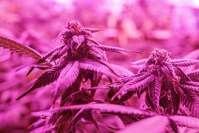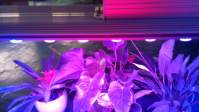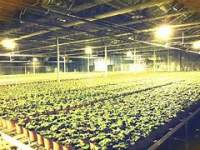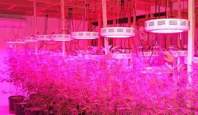LED plant light is a kind of high-efficiency and energy-saving lighting fixture, which has the potential to fundamentally change the supplementary light of plant lighting in the future. However, the lighting technology of LED plant lights is not universal. There are low-power and inferior low-cost LED plant lights on the market, but they are advertised and sold with various false advantages. Many customers have also suffered in this respect. Today, Yaorong Technology is here to tell you about the 5 product advantages of LED plant lights.
Less consumption, more energy saving
LED plant lights are more energy-efficient than traditional lamps with very high operating temperatures, such as HPS and metal halides. Most of the energy consumed by these traditional lamps is used for thermal radiation (infrared radiation). Plants do not use infrared photons in photosynthesis, but they can warm plants and the environment. When using HPS and other traditional lights in warm climates or just installing many fixtures in one area, plants can easily overheat, causing you to need additional ventilation. The power consumption of fans and air conditioners will add more energy to your planting facilities.
LED plant lights are not just a substitute for HPS lights. HPS and other HID lights cannot be placed close to plants without burning them. Although LED plant lights generate heat like all electronic devices, their operating temperature is much lower. Their light does not emit heat radiation. They can be placed close to the plant canopy, saving space and reducing energy and infrastructure requirements.
The structure of the LED plant growth lamp emits light as a downward beam. Traditional plant lights emit light in all directions, so shades and reflectors are needed to guide the light to the plants. This kind of equipment increases the volume and is not efficient in directing light to the plants, which indirectly increases energy consumption. High-quality LED grow lights are equipped with secondary optical elements. This helps to avoid "hot spots" and distribute the light evenly in the growth area. They also ensure that the photons are delivered directly to your crop.
An Energy Report of the US Department of Energy researched the energy-saving potential of LED lighting in horticultural applications and found that LED plant growth lamps provide a 24% to 30% reduction in power consumption, which is more energy-efficient than other lighting fixtures.
Low heat generation and easy management
LED plant lights do generate heat in semiconductors. But because LED grow lights do not have filaments, they are generally more effective than HPS light sources in this regard, and therefore generate less excess heat in indoor greenhouses.
Proper thermal management is essential for LED grow lights, because the increase in heat will have a negative impact on the performance of LED grow lights, including reduced light efficiency, color shift and shortened lifespan. Because LED grow lights produce very little heat, growers can use a small and reliable extraction system to handle the excess heat, so there is no need to spend a lot of time, effort or expense to deal with the excess heat.
Longer service life
LED manufacturers' claims about the lifespan of LED plant lights obscure the real product failure mechanism and mislead customers. The life expectancy of most LED grow lights is rated between 50,000 and 100,000 hours. In contrast, many other grow lights tend to last about 20,000 hours before they need to be replaced. In addition to reducing long-term replacement costs, you can also save money by reducing maintenance costs and improving energy efficiency, while using longer-life lamps to improve light quality. The research report pointed out: LED lighting has surpassed all traditional lighting technologies in terms of energy efficiency, life span, versatility and color quality.
Operating temperature is also a major factor in the life of LED plant lights, so management attention is needed.
Increase crop yield
LED plant light technology cannot provide the same output as HPS and other HID technologies. LED plant light technology has the ability to increase yield, speed up production time and improve crop quality for today's growers. With its customizable spectrum, higher yields are achieved due to the high-quality spectrum and light output that better penetrates the plant canopy.
At the same time, LED plant lights can be used to control the photoperiod of plants, so that they can be harvested several times a year. If you want to increase the light on plants and give them better light conditions, they can make plants grow better. Better harvest.
High return on investment
The cost of LED plant lights is enough to justify the investment, but it depends on one's ultimate goal, and the cost is only part of the equation. Commercial growers seek long-term solutions. Appropriate LED plant lights can meet the needs of investors and operators many times. Although LED plant lights may require higher capital expenditures (assuming no subsidies, leases or incentive plans), LED plant lights (with an expected life span of 50,000 hours) provide a comparable service life, if not significantly better than HID systems .
Compared with traditional HID lighting technologies such as HPS and MH, LED plant lights can directly and indirectly save costs. The direct savings come from the higher efficiency of the LED plant light, which uses less wattage to obtain a higher or similar level of light.
Advantages of LED plant lights in the later stage:
Lower maintenance costs: There is no need to disassemble the LED grow lights for repair or cleaning, and most diodes have a rated service life of more than 50,000 hours.
Fewer consumables: LED plant lights do not need bulbs, ballasts or drivers to be replaced.
Less water: As plants evaporate less, the evaporation of soil or media is reduced.
Lower cooling requirements: LED plant lights radiate very little heat, so energy is not wasted to cool the space and plants.
Reduce infrastructure requirements: LED plant lights can be placed close to plants, so the infrastructure can be smaller and more economical.
The technology of LED plant lights is constantly improving to bring better growth to plants with better supplementary light. People should also pay special attention when choosing. Don't listen to the suppliers' excessive bragging about product advantages. When encountering this, you can doubt it, and make a better judgment from a more perspective before making a choice.






